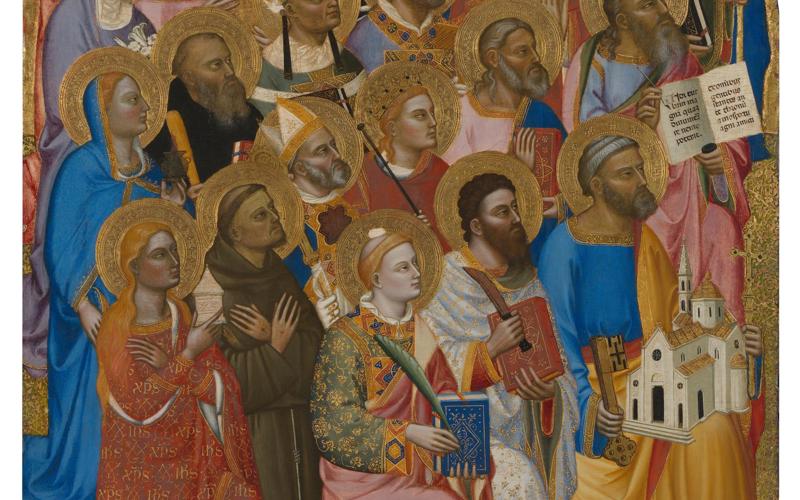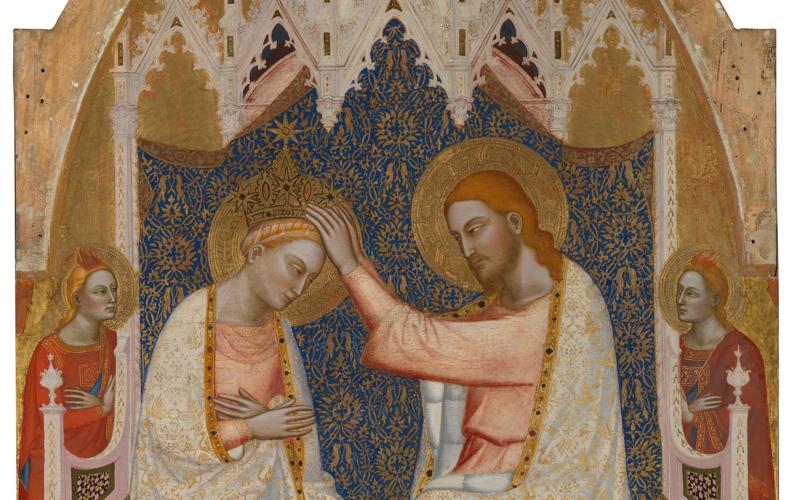Stories of art 1250-1400
- Past - Wednesday, 24 September 2025
- Past - Wednesday, 1 October 2025
- Past - Wednesday, 8 October 2025
- Past - Wednesday, 15 October 2025
- Past - Wednesday, 22 October 2025
- Wednesday, 29 October 2025
Enrol
| Standard: | £90 |
| Concessions: | £85.50 |
Please book a ticket to access the event. You will receive an E-ticket with instructions on how to access your online events, films and resources via your National Gallery account.
Please note, only one ticket can be booked per account.
Concessions are for full-time students, jobseekers, and disabled adults.
About
Explore masterpieces of medieval art including 'The Wilton Diptych', on this six-week course with Siân Walters
Join us as we examine art patronage and production during the period 1250‒1400, considering a different theme each week. How would an artist’s studio have functioned? How were paintings such as ‘The Wilton Diptych’ commissioned and displayed, and how would they have been interpreted at the time? What impact did the Black Death have upon art of the Middle Ages? We also discuss the ways in which artists’ contributions and individual commissions led to transformations in style and iconography.
The course explores masterpieces of painting, sculpture and the decorative arts, by artists such as Duccio, Giotto, Claus Sluter and Nicola Pisano. Several sessions will feature in‐depth contributions from guest speakers including Peter Schade, Head of Framing and members of the Gallery’s Conservation Department.
Find out more about 'Stories of art' and upcoming modules

The high Middle Ages witnessed a remarkable increase in art patronage. We look at the context in which this evolved, with reference to urbanisation, the emergence of the mendicant orders such as the Franciscans, and the construction of vast cathedrals throughout Europe. A growing literate elite also led to a demand for precious objects for the home, such as illuminated manuscripts and ivories.
We will also study the predominant Byzantine style and the influence of non‐Western culture on Marian iconography,
Siena was a powerful independent republic during the late 13th and 14th centuries. This period of prosperity and peace corresponded with a magnificent Golden Age of art patronage, in which painters such as Duccio di Buoninsegna and Ambrogio Lorenzetti rose to prominence. We explore examples of both sacred and secular painting, from a famous equestrian portrait of Guidoriccio da Fogliano, traditionally attributed to Simone Martini, to decorative biccherne (account book covers).
In this session we explore the ways in which art was created during the medieval and Early Renaissance period, from initial contracts between a patron and artist followed by the drawings and preparations involved in completing the final commission. We focus on the two main techniques used during the period, egg tempera and fresco, as well as the development of oil painting in Northern Europe. There will also be discussion of the decorative arts, including manuscript illumination, enamel and ivory carving.
After the break we will make a private, livestream visit to the art studio of Marco Caratelli in Siena. Marco specialises in replicating the work of medieval and Early Renaissance painters and will demonstrate some of the techniques which they used, by reproducing a painting in the National Gallery Collection.

Most of the works commissioned between 1250 and 1400 were designed for worship and yet very few of them remain in their original location, calling into question how we can interpret and view them within a museum. The newly reopened Sainsbury Wing sees works such as Segna di Bonaventura’s ‘Crucifix ‘and Jacopo di Cione’s ‘San Pier Maggiore Altarpiece’ displayed in imaginative new ways, calling to mind the original context in which they would have been viewed. This week we learn about some of the processes leading to the transformation of the rooms and the recent rehanging of the collection.
In part two we are joined by Peter Schade, Head of Framing at the National Gallery, who will discuss the new Gothic polyptych frame which he has created for Jacopo di Cione’s ‘San Pier Maggiore Altarpiece’.
Stories of Art 1250-1500
Since the majority of paintings in this period were painted for devotional purposes, understanding of saints, their stories and their status is key. Our session today also considers the language of symbolism. How can one decipher a painting through the use of symbols, how did these conventions originate and how could they be employed or tailored to suit a specific commission?
We will also be joined by National Gallery conservator Lynne Harrison who will Introduce us to the restoration process and discuss her recent conservation work on two Pietro Lorenzetti wall painting fragments, originally from the convent church of San Francesco, Siena.
Stories of Art 1250-1500
We explore how the Black Death, which swept across Europe from 1347, impacted the production and patronage of art. Seen as a punishment from God, this devastating global epidemic led to a proliferation of images dedicated to intercessory saints traditionally invoked against the plague, and large numbers of artworks or monuments designed to attain salvation after death.
We also consider the role of women as patrons and artists during the period. What kinds of women were able to transgress gender boundaries and commission works of art? How were women depicted in paintings of the period and what does this tell us about their place in society?
Your tutor
Siân Walters is an art historian and the director of Art History in Focus. She studied at Selwyn College, University of Cambridge, and has been a lecturer at the National Gallery for over 20 years. Her specialist areas of research are Italian painting, Spanish art and architecture, Flemish and Dutch painting and the relationship between dance and art. Siân also lectures for The Arts Society and leads specialist art tours abroad. She was a lecturer at University of Surrey for many years and has lived and worked in France and Venice. She is currently writing a book on still-life paintings in the National Gallery Collection.
Watch again
Can't make Wednesday evenings but don't want to miss out? No problem, you can watch again.
Each session is recorded and made available to you for the duration of the course, up until 2 weeks after the final session.
A video of the week's lecture will be uploaded and available for you to watch via your National Gallery account on Friday afternoons, in time for the weekend.
Format
Each session lasts for 2 hours and includes a lecture delivered by the course lecturer followed by a short break and further discussion.
Time will be allowed for questions and discussion via Q&A.
Handouts will be available via your National Gallery account on Tuesday mornings.
Optional homework is provided to help you prepare for the following week's session.
Booking information
This is an online ticketed course hosted on Zoom. Please book a ticket to access the course. Only one ticket can be booked per account.
You will be emailed an E-ticket with instructions on how to access the course via your National Gallery account. All course information including your Zoom link, weekly handouts, and recordings will be available here.
Your link will be valid for the duration of the course.
Booking after the course has started
You are welcome to join the module at any point during its six-week run. You will gain access to all the recordings until two weeks after the final session.





